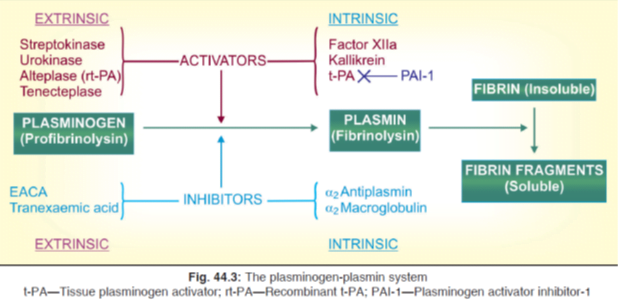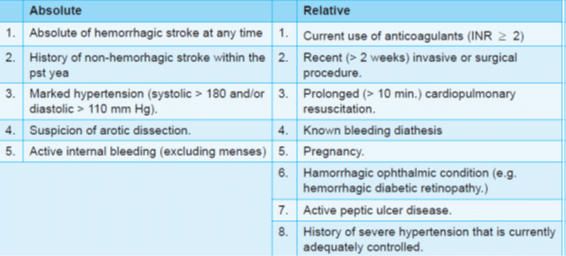FIBRINOLYTICS (Thrombolytics)
- These are drugs used to lyse thrombi/clot to recanalize occluded blood vessels (mainly coronary artery).
- They are therapeutic rather than prophylactic and work by activating the natural fibrinolytic system
- Pathophysiology à Hemostatic plug of platelets formed at the site of injury to blood vessels is reinforced by fibrin deposition to form a thrombus.
- Once repair is over, the fibrinolytic system is activated to remove the fibrin.
- The enzyme responsible for digesting fibrin à Plasmin generated from plasminogen by tissue plasminogen activator (t-PA), which is produced primarily by vascular endothelium.
- The t-PA selectively activates fibrin-bound plasminogen within the thrombus, and any plasmin that leaks is inactivated by circulating antiplasmins.
- Thus, activation of circulating plasminogen induces a lytic state whose major complication is hemorrhage.

- In general, venous thrombi are lysed more easily by fibrinolytics than arterial, and recent thrombi respond better.
- They have little effect on thrombi > 3 days old.
- The clinically important fibrinolytics are:
- Streptokinase
- Urokinase
- Alteplase (rt-PA)
- Reteplase
- Tenecteplase
Streptokinase
- Obtained from β haemolytic Streptococci group C,
- it is the first fibrinolytic drug to be used clinically, but is not employed now except for considerations of cost.
- Streptokinase is inactive as such; combines with circulating plasminogen molecules to form an activator complex which then causes limited proteolysis of other plasminogen molecules to generate the active enzyme plasmin.
- Stk. is non-fibrin specific, i.e. activates both circulating as well as fibrin bound plasminogen.
- Therefore, it depletes circulating fibrinogen and predisposes to bleeding.
- Compared to newer more fibrin-specific tissue plasminogen activators (alteplase, etc.) it is less effective in opening occluded coronary arteries, and causes less reduction in MI related mortality.
- other disadvantages à Antistreptococcal antibodies due to past infections inactivate considerable fraction of the initial dose of Stk -à A loading dose therefore is necessary.
- Stk is antigenic—can cause hypersensitivity reactions; anaphylaxis occurs in 1–2% patients.
- It cannot be used second time due to neutralization by antibodies generated in response to the earlier dose.
For MI: 7.5–15 lac IU infused i.v. over 1 hr.
Urokinase
- enzyme isolated from human urine; but commercially prepared from cultured human kidney cells.
- activates plasminogen directly
- nonantigenic
- Indicated in patients in whom streptokinase has been given for an earlier episode, but is seldom used now.
Alteplase (recombinant tissue plasminogen activator (rt-PA)
- moderately specific for fibrin-bound plasminogen, so that circulating fibrinogen is lowered only by ~ 50%.
- It is rapidly cleared by liver and inactivated by plasminogen activator inhibitor-1 (PAI-1).
- The plasma t½ is 4–8 min. Because of the short t½, it needs to be given by slow i.v. infusion and often requires heparin coadministration.
- nonantigenic, but expensive.
Reteplase
- modified form of rt-PA that is longer acting, but somewhat less specific for fibrin-bound plasminogen.
- The longer duration of action enables bolus dose administration (10 mg over 10 min repeated after 30 min).
Tenecteplase – rt-PA
- higher fibrin selectivity, slower plasma clearance (longer duration of action) and resistance to inhibition by PAI-1.
- only fibrinolytic agent that can be injected i.v. as a single bolus dose over 10 sec, while alteplase requires 90 min infusion.
- This feature makes it possible to institute fibrinolytic therapy immediately on diagnosis of ST segment elevation myocardial infarction (STEMI), even during transport of the patient to the hospital.
- Risk of noncerebral bleeding may be lower with tenecteplase, but cranial bleeding incidence is similar.
Uses of fibrinolytics
- Acute myocardial infarction
- Chief indication à alternative first line approach to emergency percutaneous coronary intervention (PCI) with stent placement.
- Thrombolysis may be favoured if it can be started within 1–2 hours of onset. After 3 hours, PCI is favoured.
- Recanalization of thrombosed coronary artery has been achieved in 50–90% cases.
- Time lag in starting the infusion is critical for reducing area of necrosis, preserving ventricular function and reducing mortality.
- Aspirin with or without heparin is generally started concurrently or soon after thrombolysis to prevent re-occlusion.
- Alteplase has advantages over streptokinase, including higher thrombolytic efficacy. However, incidence of haemorrhage is not lower.
- Deep vein thrombosis in leg, pelvis, shoulder etc
- up to 60% patients can be successfully treated.
- Thrombolytics can decrease subsequent pain and swelling, but the main advantage is preservation of venous valves and may be a reduced risk of pulmonary embolism, though at the risk of haemorrhage.
- Pulmonary embolism
- Fibrinolytic therapy is indicated in large, life-threatening PE.
- The lung function may be better preserved, but reduction in mortality is not established.
- Peripheral arterial occlusion
- Fibrinolytics re-canalise ~40% limb artery occlusions, especially those treated within 72 hr.
- However, it is indicated only when surgical thrombectomy is not possible.
- Regional intraarterial fibrinolytics have been used for limb arteries with greater success.
- Peripheral arterial thrombolysis is followed by short-term heparin and long-term aspirin therapy.
- Stroke:
- Thrombolytic therapy of ischaemic stroke is controversial.
- Possibility of improved neurological outcome is to be balanced with risk of intracranial haemorrhage.
- However, alteplase is approved for use in ischaemic stroke, and current opinion strongly recommends use of i.v. alteplase in carefully selected patients who can be treated within 3 hours of onset, and in whom intracranial haemorrhage is ruled out along with all risk factors for bleeding
Contraindications

ANTIFIBRINOLYTIC DRUGS
- drugs which inhibit plasminogen activation and dissolution of clot, and
- are used to check fibrinolysis associated bleeding.
Epsilon amino-caproic acid (EACA)
- It is a lysine analogue
- combines with the lysine binding sites of plasminogen and plasmin so that the latter is not able to bind to fibrin and lyse it.
- specific antidote for fibrinolytic agents
- primary indication is to counteract the effect of fibrinolytic drugs and bleeding due to their use.
- In haemophiliacs, it has adjunctive value for controlling bleeding due to tooth extraction, prostatectomy, trauma, etc.
- s/e à intravascular thrombosis. Rapid i.v. injection results in hypotension, bradycardia and may be arrhythmias. It should be used cautiously when renal function is impaired. Myopathy occurs rarely.
The large dose needed is a limitation, and tranexamic acid is mostly preferred.
Tranexamic acid
- Like EACA, it binds to the lysine binding site on plasminogen and prevents its combination with fibrin leading to fibrinolysis.
- 7 times more potent than EACA, and is preferred for prevention/control of excessive bleeding due to:
• Fibrinolytic drugs.
• Cardio-pulmonary bypass surgery.
• Tonsillectomy, prostatic surgery, tooth extraction in haemophiliacs.
• Menorrhagia, especially due to IUCD.
• Recurrent epistaxis, hyphema due to ocular trauma, peptic ulcer.
